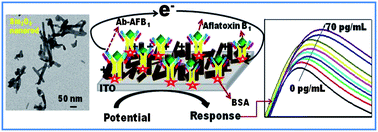A highly efficient rare earth metaloxidenanorods based platform for aflatoxin detection†
Abstract
The nanostructured

Maintenance work is planned from 09:00 BST to 12:00 BST on Saturday 28th September 2024.
During this time the performance of our website may be affected - searches may run slowly, some pages may be temporarily unavailable, and you may be unable to access content. If this happens, please try refreshing your web browser or try waiting two to three minutes before trying again.
We apologise for any inconvenience this might cause and thank you for your patience.
* Corresponding authors
a
Department of BIN Fusion Technology and Department of Polymer-Nano Science and Technology, Chonbuk National University, Jeonju, Jeonbuk 561-756, Korea
E-mail:
jay_singh143@yahoo.co.in, dlee@jbnu.ac.kr, lsh1@jbnu.ac.kr
Fax: +82-63-270-2341
Tel: +82-063-270-2343
b
Department of Biotechnology, Delhi Technological University, Shahbad Daulatpur, Main Bawana Road, Delhi 110042, India
E-mail:
appan.roychoudhury@gmail.com
c
Department of Physics, Dehradun Institute of Technology (DIT), School of Engineering, Greater Noida 201308, India
E-mail:
84.srivastava@gmail.com
d
Department of Science & Technology Centre on Biomolecular Electronics, Biomedical Instrumentation Section, Material Physics and Engineering Division, CSIR-National Physical Laboratory, Dr K. S. Krishnan Marg, New Delhi 110012, India
E-mail:
pratimarsolanki@gmail.com, bansi.malhotra@gmail.com
Fax: +91-11-27871023
Tel: +91-11-27294668
e
Special Centre for Nano Sciences, Jawaharlal Nehru University, New Delhi 110067, India
E-mail:
partima@mail.jnu.ac.in
The nanostructured

 Please wait while we load your content...
Something went wrong. Try again?
Please wait while we load your content...
Something went wrong. Try again?
J. Singh, A. Roychoudhury, M. Srivastava, P. R. Solanki, D. W. Lee, S. H. Lee and B. D. Malhotra, J. Mater. Chem. B, 2013, 1, 4493 DOI: 10.1039/C3TB20690D
To request permission to reproduce material from this article, please go to the Copyright Clearance Center request page.
If you are an author contributing to an RSC publication, you do not need to request permission provided correct acknowledgement is given.
If you are the author of this article, you do not need to request permission to reproduce figures and diagrams provided correct acknowledgement is given. If you want to reproduce the whole article in a third-party publication (excluding your thesis/dissertation for which permission is not required) please go to the Copyright Clearance Center request page.
Read more about how to correctly acknowledge RSC content.
 Fetching data from CrossRef.
Fetching data from CrossRef.
This may take some time to load.
Loading related content
